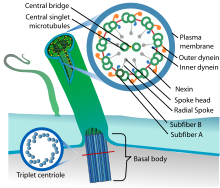
Back اعتلال الأهداب الخلوية Arabic Ziliopathie German Ciliopatía Spanish Siliopatia Finnish Ciliopathie French Ciliopatia Italian 繊毛病 Japanese Ciliopathie Dutch Ciliopatie Polish Ciliopatia Portuguese
| Ciliopathy | |
|---|---|
 | |
| Eukaryotic cilium | |
| Specialty | Medical genetics |
A ciliopathy is any genetic disorder that affects the cellular cilia or the cilia anchoring structures, the basal bodies,[1] or ciliary function.[2] Primary cilia are important in guiding the process of development, so abnormal ciliary function while an embryo is developing can lead to a set of malformations that can occur regardless of the particular genetic problem.[3] The similarity of the clinical features of these developmental disorders means that they form a recognizable cluster of syndromes, loosely attributed to abnormal ciliary function and hence called ciliopathies. Regardless of the actual genetic cause, it is clustering of a set of characteristic physiological features which define whether a syndrome is a ciliopathy.
Although ciliopathies are usually considered to involve proteins that localize to motile and/or immotile (primary) cilia or centrosomes, it is possible for ciliopathies to be associated with unexpected proteins such as XPNPEP3, which localizes to mitochondria but is believed to affect ciliary function through proteolytic cleavage of ciliary proteins.[4]
Significant advances in understanding the importance of cilia were made in the mid-1990s. For example, the discovery of the role of cilia in embryonic development, identification of ciliary defects in genetic disorders such as Polycystic kidney disease, Bardet–Biedl syndrome and Primary ciliary dyskinesia.[5][6] However, the physiological role that this organelle plays in most tissues remains elusive. Additional studies of how ciliary dysfunction can lead to such severe disease and developmental pathologies is still a subject of current research.[7]
- ^ Adams M, Smith UM, Logan CV, Johnson CA (2008). "Recent advances in the molecular pathology, cell biology and genetics of ciliopathies". Journal of Medical Genetics. 45 (5): 257–267. doi:10.1136/jmg.2007.054999. PMID 18178628.
- ^ Lee JH, Gleeson JG (May 2010). "The role of primary cilia in neuronal function". Neurobiol. Dis. 38 (2): 167–72. doi:10.1016/j.nbd.2009.12.022. PMC 2953617. PMID 20097287.
- ^ Powles-Glover N (September 2014). "Cilia and ciliopathies: classic examples linking phenotype and genotype-an overview". Reproductive Toxicology (Elmsford, N.Y.). 48: 98–105. doi:10.1016/j.reprotox.2014.05.005. PMID 24859270.
- ^ Hurd TW, Hildebrandt F (2011). "Mechanisms of Nephronophthisis and Related Ciliopathies". Nephron Exp. Nephrol. 118 (1): e9–e14. doi:10.1159/000320888. PMC 2992643. PMID 21071979.
- ^ Cowley BD, Bissler JJ, eds. (2018). Polycystic Kidney Disease. New York: Springer. p. 87. doi:10.1007/978-1-4939-7784-0. ISBN 978-1-4939-7782-6.
- ^ Kenny TD, Beales PL (2014). Ciliopathies: a reference for clinicians. Oxford: Oxford University Press. ISBN 978-0-19-965876-3.
- ^ Cite error: The named reference
davenport2008was invoked but never defined (see the help page).
© MMXXIII Rich X Search. We shall prevail. All rights reserved. Rich X Search